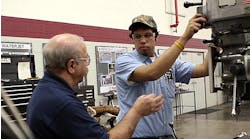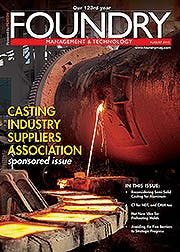Never minding the ancient adage, most readers think they can draw some conclusions about a magazine by the image on its cover, or at least that’s my usual experience. The cover of this issue shows an ingot casting process, and while that is something of a reach for most foundries it will, I am sure, strike a note of familiarity. Some correspondents will carp that it’s not relevant to what they do, that they cannot appreciate the significance, etc. I will not argue with them, because their minds are probably already set against the possibility of understanding the connection between a process that is perhaps obsolete, or at least obsolescent, and the advanced production processes and technologies that they oversee. It would be far more to hope they can see the simple beauty in the process shown there, or the skill on display or to see some similarity to their own life or work.
Perhaps this is a personal obsession of mine. My father was a cardiologist, and what he did has virtually no significance to what I do now, but every two weeks the Journal of the American Medical Association would arrive in the mail. For a boy of eight or nine it was an extraordinary thing to flip through that dense folio and gawk at the undisguised human condition. There would have been a lot of charts and tables too, and slides and diagrams revealing developments at a cellular or microscopic level. But, of course, it was the deformed or diseased persons who held my attention. I would stare and wonder what happened to those people. I was not sympathetic, just immature. I knew it was unseemly, but my curiosity exceeded the rules of good behavior.
The JAMA editors were not ghouls, however, and my dad took care to make sure I studied the covers of those issues too. Because there, on each issue, would be found some remarkable image licensed from the Metropolitan Museum of Art or the Isabella Stewart Gardner Museum, paintings by Rembrandt or Vermeer, or Whistler or Eakins or Homer, paintings that showed humanity in all its conditions, but invariably with a beauty and grace that communicated none of us is ideal but all have merit.
My father made clear to me that it was the front of JAMA that I should study, because while the interior pages were fascinating (and, of course, illuminating to someone at a much higher level of understanding than I have ever achieved), it was there on the cover that he hoped I’d learn to appreciate people for their accomplishments — and to know that such potential lies in everyone, regardless of their deformed, diseased, or debased state. The artists were no different than the research patients, he’d note. And neither were we.
Each month we select a cover that will encourage readers to dig in to our pages, but for my taste the cover also should enlighten them, and help them see their own circumstances in a wider frame.
This is the issue that we assemble each year to highlight the achievements and capabilities of the Casting Industry Suppliers Association, who are not metalcasters but who share the understanding and concerns, and the risks of metalcasters. They make every one of our issues possible by their advertising support, and they make metalcasting a viable industry by their research. Their resources make it possible for foundries and diecasters to overcome their own challenges, and their contributions to the industry no less significant than the product designers, casting buyers, or indeed the metalcasters themselves.
Metalcasters that acquire supplies, capital goods, and services are right to expect exceptional quality for their purchases, but they miss something if they do not see the common understanding that links the supplier to the customer.
As consumers in a commercially focused society we are all conditioned to keep a focus on our own demands, our own tastes, our own preferences. We can see or hear of extraordinary things and let them pass as news updates, simply because we’re busy, or too distant to raise concern. It’s not the information that numbs us. We have made ourselves that way.
As product development and marketing becomes more individually targeted, this is a trend I do not expect to see reversed. But if we simply demand that our demands are met, our orders are filled, or our curiosities are satisfied, then we miss the many smaller opportunities to be humanized.










